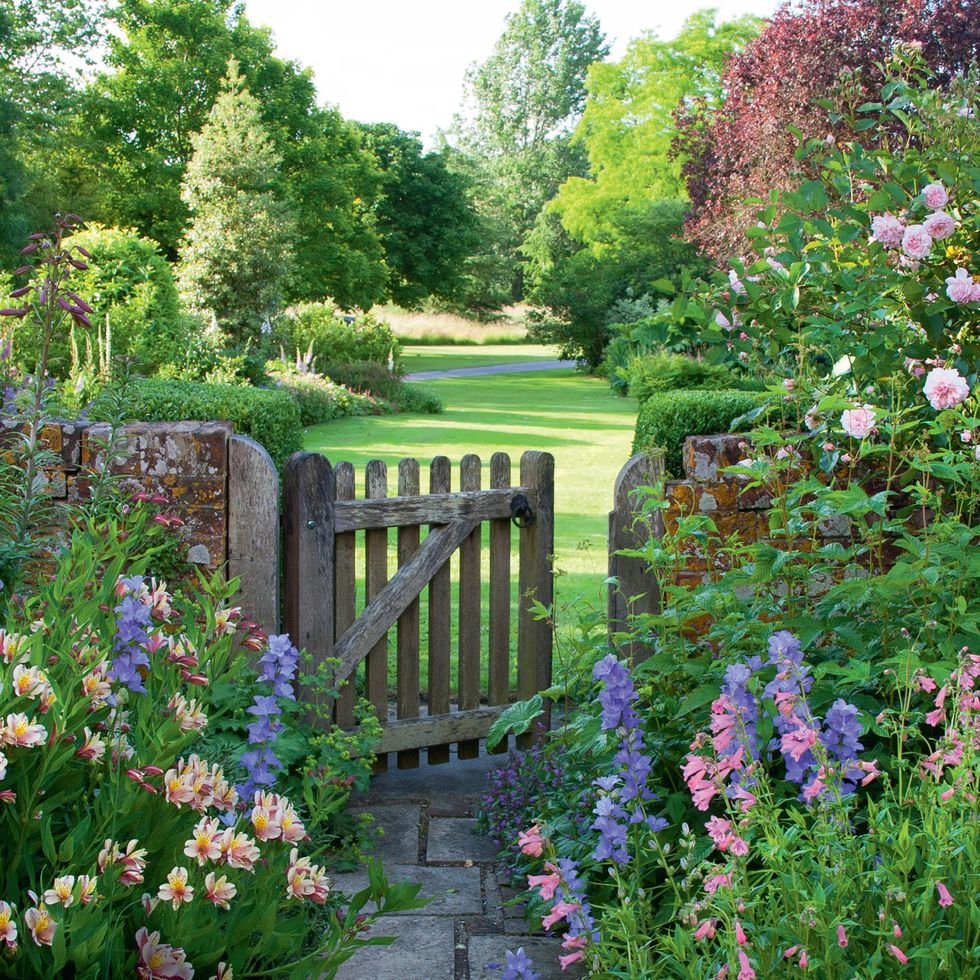This feature is from Country Living’s Glorious Gardens special which is on sale now. Make sure you pick up your copy when you next pop to the shops or order online here.
The quintessential cottage garden is a classic style that can, given the right planting, structures and colour scheme, be easily recreated. It’s a timeless garden design which attracts wildlife, celebrates greenery and embraces rustic charm.
Here are eight ways you can achieve the cottage garden look at home, including paving materials, planting, trees and furniture.
1. Paving materials
 Glorious Gardens, by Country Living| GapPhotos, Lynn Keddie
Glorious Gardens, by Country Living| GapPhotos, Lynn Keddie
Keep it simple with stone slabs, cobbles or bricks. Old bricks were often recycled from tumbledown buildings in traditional cottage gardens, but as they are now harder to come by, using them sparingly, as features set into a paved path, is a cheaper option. Or check local small ads for brick ‘seconds’. Though not suitable for building, they’re ideal for the garden. Paving companies also do simulated bricks, made from cement instead of clay, but they do not weather as attractively.
2. Boundaries Glorious Gardens, by Country Living|Michelle Garrett
Glorious Gardens, by Country Living|Michelle Garrett
In towns and villages, formal railings or a white picket form the classic boundary to a cottage garden, allowing plants to weave between or tumble over the top. However a rural setting requires something more rough-hewn and rustic. A boundary fence can be productive (planted with loganberries, for example) or deter intruders when combined with prickly plants such as the extremely thorny Rosa rugosa. If privacy is important, a native hedge establishes quickly.
3. Trees
 Glorious Gardens, by Country Living|GAP Photos/Maxine Adcock
Glorious Gardens, by Country Living|GAP Photos/Maxine Adcock
Productivity has always been important in cottage gardens and if you’re lucky enough to have an old fruit tree in your plot, it’s worth having it professionally pruned, or learning how to do this yourself, so that it continues to bear fruit. If the fruit just isn’t palatable, plant a rambling rose or clematis to festoon its branches. When introducing new trees, source local varieties of apple, pear, plum or cherry, or for something more unusual, mulberry, medlar or quince.
4. Furniture
 Glorious Gardens, by Country Living|GAP Photos/Friedrich Strauss
Glorious Gardens, by Country Living|GAP Photos/Friedrich Strauss
Choose something rustic and durable. Salvage yards can be a good place to source vintage garden benches, and old-fashioned cushions complete the picture. Frame your seating with a wooden arbour and plant scented climbers over it. An old tree positively begs for a swing, while two will provide anchor points for a hammock.
SHOP GARDEN FURNITURE
5. Walls
 Glorious Gardens, by Country Living|living4media, Ofenstein, Inge
Glorious Gardens, by Country Living|living4media, Ofenstein, Inge
The walls of your house, shed or garage can all be used as support acts for climbing plants and will showcase them to good effect. With the assistance of trellis or vine-eyes and wires, climbing roses, honeysuckle and clematis will clothe specific areas, soften the hard edges of a building, clamber around windows and doorways and disguise any eyesores.
Read our guide on the 30 best climbing plants for all gardens.
6. Containers
 Glorious Gardens, by Country Living| Michelle Garrett
Glorious Gardens, by Country Living| Michelle Garrett
You can build character by recycling discarded items and repurposing them. A collection of old tin baths and buckets can find a new life as containers for salads or succulents, and an old stone sink filled with herbs or cut-and-come-again salad leaves can be both functional and beautiful. Use old wooden wine boxes, too – they make attractive planters for growing cherry tomatoes.
Read our guide on 7 fruit and vegetables you can easily grow in pots.
7. Classic flowers
 Glorious Gardens, by Country Living| GAP Photos,Elke Borkowski
Glorious Gardens, by Country Living| GAP Photos,Elke Borkowski
Some foxgloves bloom in their second year, die but self-seed. Aquilegia flowers early and self-seeds around. Hollyhock has tall spires of tissue-paper flowers. Houseleek grows in succulent rosettes on clay tile roofs or in shallow troughs. Honesty’s purple flowers brighten the spring garden. Lavender is the perfect fragrant edging for a path. Sweet peas scrambling up hazel poles are a must.
We interviewed Chelsea Flower Show Gold Medal-winner, Mark Gregory on the topic of cottage garden planting too, and he suggested the below:
8. Plant supports
 Glorious Gardens, by Country Living|GAP Photos/Ne, Neil Holmes
Glorious Gardens, by Country Living|GAP Photos/Ne, Neil Holmes
Whether you have a rose-covered arch over the gate, a wigwam to anchor sweet peas or poles to hold up a row of runner beans, plant supports are an integral part of a cottage garden. The added height they offer also lends variation and interest to the borders. The general rule of thumb is that the more rural your garden, the more rustic the materials you need, while a town garden can take more sophisticated finishes such as paint and wrought iron.







